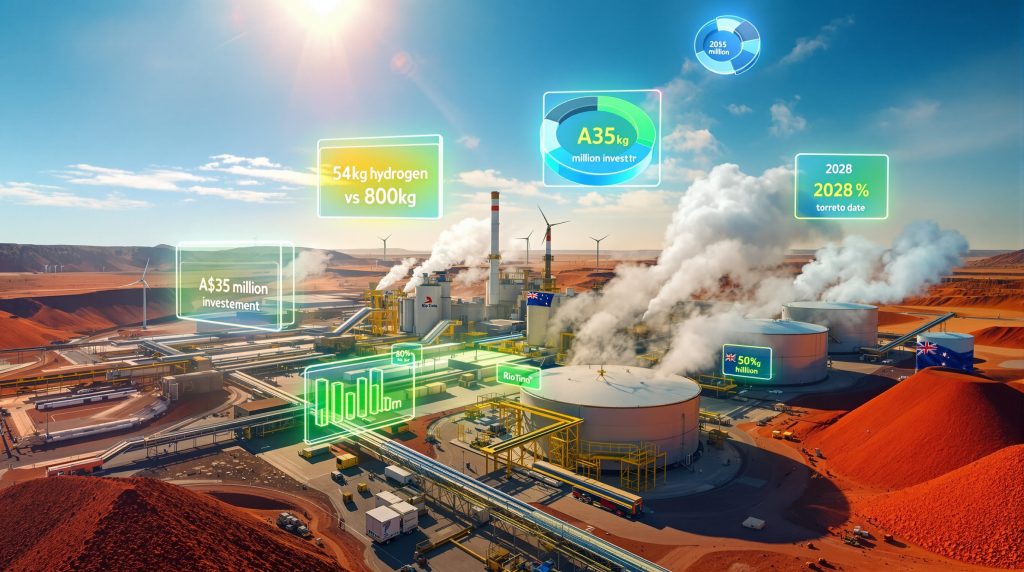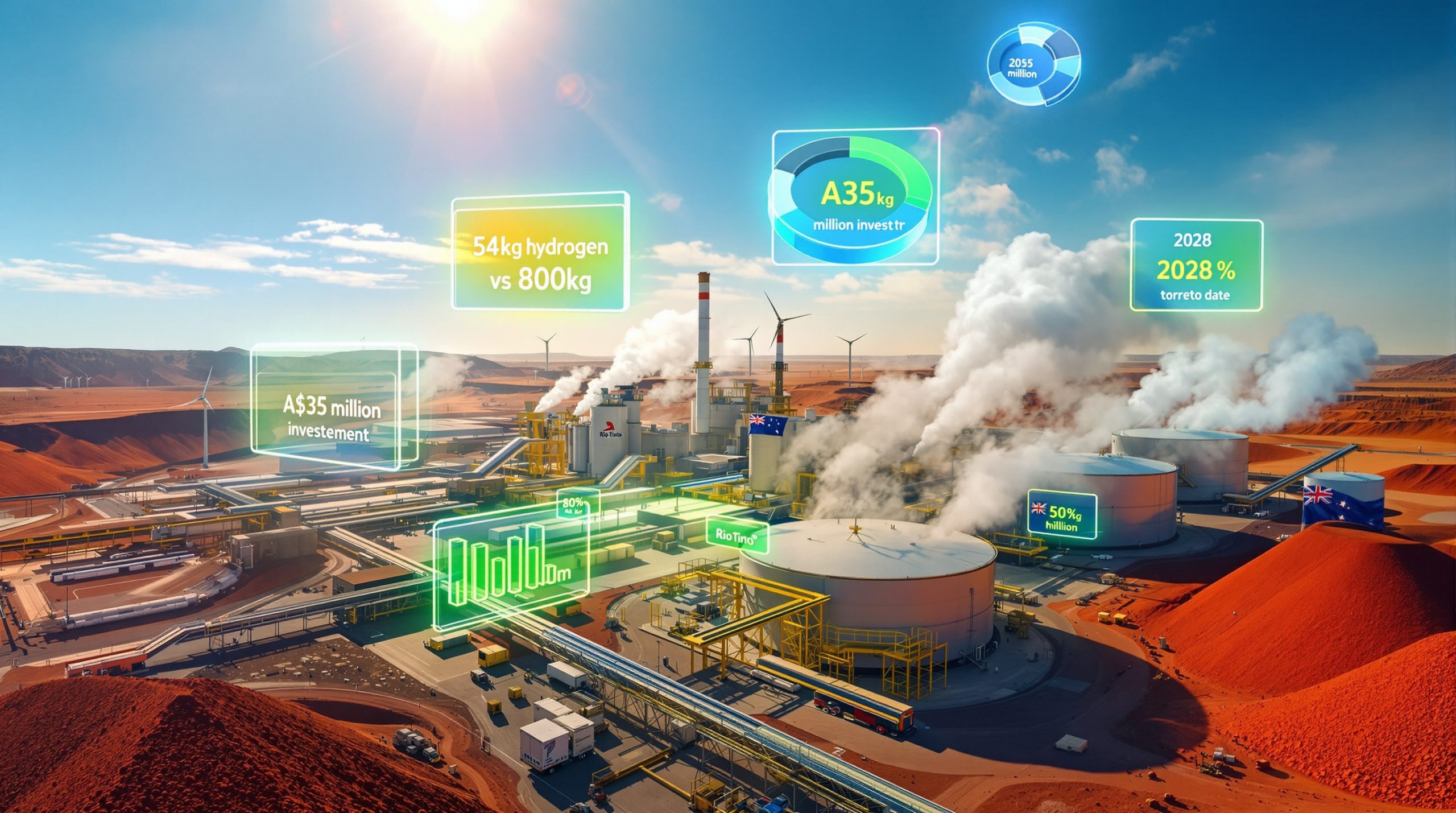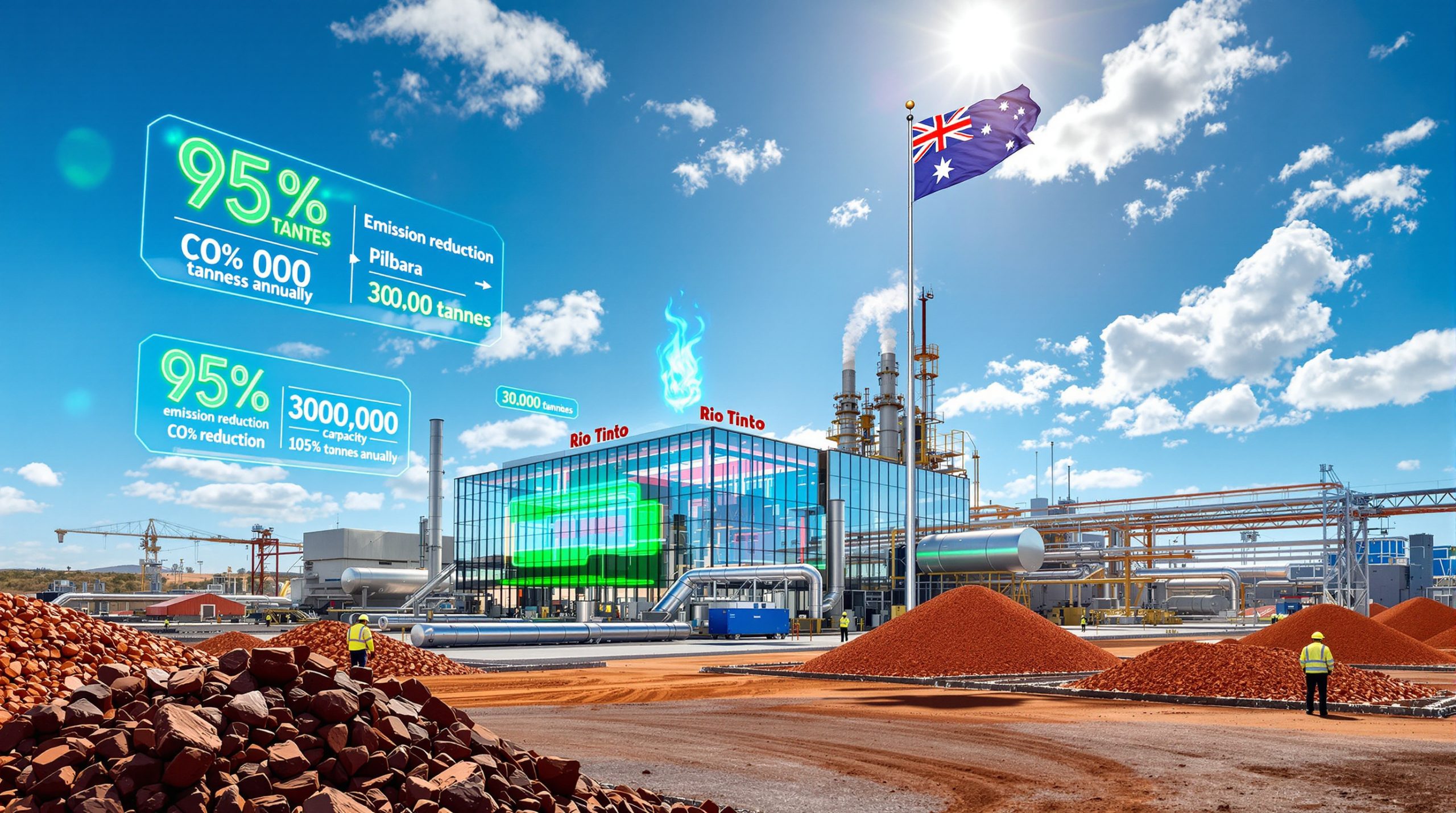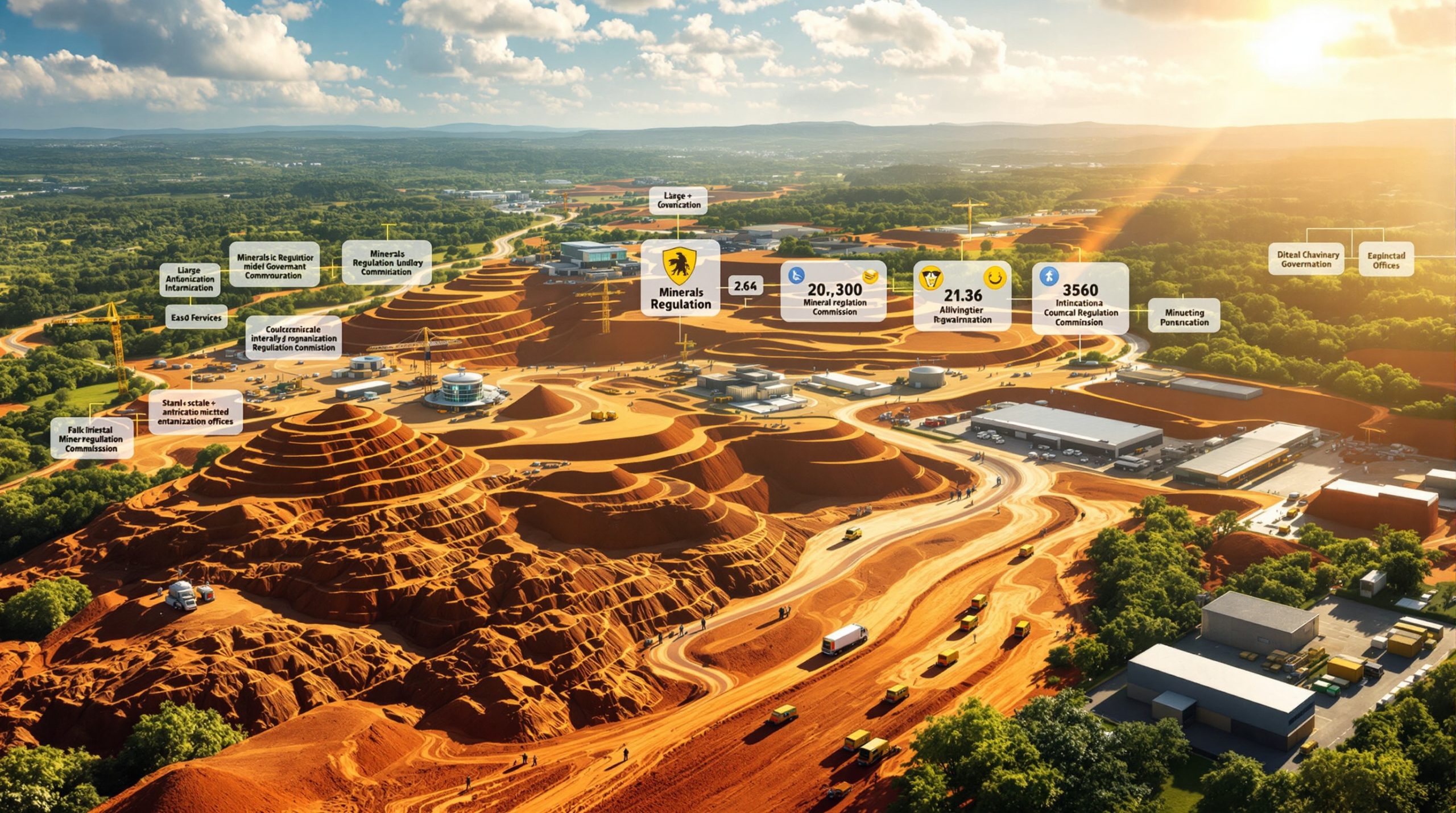Rio Tinto's Strategic Investment in Australia's Green Steel Future
Rio Tinto's commitment to supporting Australian low-carbon iron production represents a pivotal shift in the global mining landscape. The Anglo-Australian mining giant has positioned itself at the forefront of sustainable steelmaking through strategic investments and technological partnerships that could reshape the future of iron production across the continent. Furthermore, this initiative demonstrates how rio tinto supports australian low-co2 iron plant development through comprehensive financial backing and technological expertise.
How Rio Tinto Supports Australian Low-CO2 Iron Plant Development
A$35 Million Partnership with Calix Technology
Rio Tinto has committed A$35 million (USD $23 million) to support Calix's groundbreaking Zero Emissions Steel Technology demonstration plant in Kwinana, Western Australia. This comprehensive investment package demonstrates the mining company's strategic approach to green iron metal project development:
- A$8 million in direct cash funding for project development
- 10,000 tonnes of premium Pilbara iron ore for plant commissioning and operational testing
- Extensive in-kind technical support including engineering expertise and operational knowledge sharing
- Non-exclusive technology licensing rights providing future commercial application opportunities
The partnership extends beyond traditional financial backing, creating a vertically integrated approach that combines Rio Tinto's world-class iron ore resources with Calix's innovative hydrogen-based reduction technology. This arrangement allows both companies to validate the commercial viability of low-carbon iron production while maintaining operational flexibility for future technology deployment.
Strategic Value Beyond Capital Investment
Rio Tinto's investment structure reflects sophisticated risk management and portfolio optimisation. The non-exclusive licensing arrangement provides technology access without restricting the company's ability to evaluate competing green steel pathways. This approach enables Rio Tinto to maintain exposure to breakthrough opportunities while diversifying technological risks across multiple development programmes.
The provision of 10,000 tonnes of Pilbara iron ore serves multiple strategic purposes. It ensures consistent, verified feedstock quality for the demonstration facility while simultaneously validating ore compatibility with hydrogen-based reduction processes. Moreover, this validation becomes particularly important as Calix's technology can process various ore grades, including lower-grade fines that typically require costly pelletisation for traditional blast furnace applications.
Revolutionary Efficiency in Calix's Zero Emissions Steel Technology
Unprecedented Hydrogen Utilisation Rates
Calix's Zesty process achieves remarkable hydrogen efficiency that distinguishes it from competing technologies in the green steel sector:
| Technology Pathway | Hydrogen Required per Tonne of Iron | Efficiency Advantage |
|---|---|---|
| Calix Zesty Process | 54 kg | Baseline |
| Fortescue's Technology | 800 kg | 93% higher consumption |
| Traditional Blast Furnace | N/A (coal/coke based) | Carbon-intensive alternative |
This 93% reduction in hydrogen requirements compared to Fortescue's approach represents a fundamental advancement in thermodynamic efficiency. The dramatic difference suggests either superior thermal management, alternative chemical reduction pathways, or hybrid mechanisms that combine hydrogen reduction with electric heating systems.
Technical Innovation Framework
The Zesty technology employs several key innovations that enable its superior efficiency:
Electric Heating Integration: Direct electric resistance heating eliminates thermal losses associated with fossil fuel combustion, providing precise temperature control throughout the reduction process.
Flexible Ore Processing: The technology can accommodate various iron ore grades and types, including lower-grade fines that represent approximately 30-40% of Pilbara production. This flexibility eliminates costly preprocessing requirements like pelletisation or sintering.
Modular Scalability: The demonstration plant's 30,000 tonnes annual capacity enables staged commercial deployment, reducing capital risk while proving operational reliability at meaningful production scales. In addition, this approach supports Australia's sustainable mining transformation objectives.
Reduced Infrastructure Footprint: The integrated design requires significantly smaller facilities compared to conventional blast furnaces, which typically operate at 10,000+ tonnes daily capacity and require extensive auxiliary systems for ore preparation and gas management.
Strategic Reallocation from BioIron to Calix Partnership
Resource Optimisation Through Technology Pivoting
Rio Tinto's decision to pause its A$215 million BioIron pilot plant reflects strategic portfolio management rather than technological failure. The BioIron project, targeting 1 tonne per hour of iron production using agricultural waste and solar-powered microwave energy, faced several commercial challenges that made the Calix partnership more attractive:
Timeline Advantages: Calix's Zesty technology has progressed through laboratory validation phases, while BioIron remained in final design stages with undefined commercialisation timelines.
Capital Efficiency: The Australian Renewable Energy Agency's A$44.9 million grant to Calix reduces Rio Tinto's required capital deployment compared to fully funding BioIron development. Furthermore, this demonstrates significant decarbonisation benefits through public-private partnerships.
Technology Maturation: Hydrogen-based direct reduction represents a more established technological pathway with proven commercial applications globally, while biomass-microwave reduction faces scaling challenges related to feedstock variability and energy consistency.
Production Scale: The Zesty demonstration plant targets 30,000 tonnes annually, representing 3.4 times the production capacity of the BioIron facility at comparable development stages.
Site Repurposing and Option Value Preservation
The potential repurposing of the original BioIron location for the Calix demonstration plant represents efficient asset utilisation. This transition maintains theoretical optionality for future BioIron development if commercial hydrogen availability constraints emerge, while immediately advancing near-term green steel objectives.
The paused status, rather than formal termination, preserves Rio Tinto's intellectual property investments in biomass reduction technology. This approach maintains strategic flexibility as renewable energy costs continue declining and biomass supply chains mature across Western Australia.
NeoSmelt Consortium and Multi-Technology Strategy
Collaborative Approach to Technology Development
Rio Tinto participates in the NeoSmelt consortium alongside major industry players, developing Australia's largest ironmaking pilot plant with 30,000-40,000 tonnes annual capacity. The consortium structure pools complementary capabilities:
Consortium Composition:
- Rio Tinto: Iron ore feedstock and market intelligence
- BHP Billiton: Metallurgical expertise and operational knowledge
- BlueScope Steel: Steelmaking operational perspective and downstream applications
- Woodside Energy: Hydrogen infrastructure development and energy integration
- Mitsui Iron Ore: Asian market access and financing capabilities
Alternative Technology Pathway
The NeoSmelt project employs Direct Reduced Iron (DRI) combined with Electric Smelting Furnace (ESF) technology, representing an alternative approach to the Calix direct reduction method. According to Rio Tinto's recent announcement, this technology offers substantial decarbonisation potential:
Two-Stage Process Architecture:
- Reduction Stage: Iron ore reduced to metallic iron through hydrogen-based chemistry, achieving 90%+ metallisation in solid form
- Melting Stage: DRI charged into Electric Arc Furnaces operating on renewable electricity for final molten iron production
Commercial Advantages:
- Proven EAF Technology: Electric Arc Furnaces operate at 150+ facilities globally, demonstrating commercial scalability
- Operational Flexibility: DRI can be stored as intermediate product, allowing production scheduling flexibility to match renewable energy availability
- Emission Reduction Potential: Up to 80% reduction compared to conventional blast furnaces through hydrogen reduction and renewable electricity
Government Policy Framework Supporting Green Steel Development
Federal Investment Architecture
The Australian government has implemented comprehensive support mechanisms for low-carbon steel production. The Australian Renewable Energy Agency awarded Calix a A$44.9 million grant in July 2024, representing substantial public backing for hydrogen-based iron production technology.
Policy Support Elements:
- Direct Grants: ARENA funding reduces private sector capital requirements for early-stage demonstration projects
- Procurement Commitments: Government purchasing agreements create guaranteed demand, reducing commercial risk for pioneer projects
- Infrastructure Coordination: State-level support ensures utility connections and regulatory approvals align with project timelines
Market Creation Through Demand Guarantee
Western Australia's commitment to procure low-emission steel from local producers creates market-pull mechanisms that complement technology-push investments. This dual approach addresses the typical commercialisation challenge where innovative technologies struggle to find initial customers despite technical advantages. Consequently, this initiative supports Australia's iron ore industry leadership in sustainable steel production.
The procurement policy modifications prioritising domestic green steel suppliers provide revenue certainty during the critical demonstration-to-commercial scaling phase. This policy framework reduces technology adoption risks that private investors face when evaluating green steel investments.
Timeline Challenges and Commercial Milestones
Calix Zesty Development Schedule
The demonstration plant development follows an ambitious but achievable timeline:
2025: Final design completion and environmental permitting processes
2026-2027: Construction phase execution with equipment installation and commissioning
2028: Commercial operation commencement targeting 30,000 tonnes annually
2030+: Potential scaling to full commercial production levels exceeding 100,000 tonnes annually
Critical Success Dependencies
Several factors could influence project execution timelines:
"Hydrogen Supply Chain Development: Green hydrogen production capacity must align with demonstration plant operational requirements, requiring coordination between renewable electricity generation, electrolysis capacity, and hydrogen storage infrastructure."
"Grid Decarbonisation Progress: The carbon intensity of grid electricity directly impacts the lifecycle emissions profile of electric heating systems, influencing the technology's environmental credentials."
"Regulatory Approval Efficiency: Environmental permitting and operational licensing timelines could accelerate or delay commercial operation commencement."
"Skilled Workforce Availability: Hydrogen-based reduction technology requires specialised operational expertise currently limited within traditional steelmaking workforces."
Global Operational Impact for Rio Tinto
Strategic Positioning for Energy Transition
Rio Tinto's Australian green steel investments position the company advantageously across multiple dimensions of the global energy transition. These strategic benefits extend beyond immediate operational returns. However, rio tinto supports australian low-co2 iron plant initiatives that provide substantial competitive advantages:
ESG Enhancement: Environmental, Social, and Governance credentials improve access to institutional capital increasingly focused on sustainable investment mandates.
Carbon Pricing Protection: Reduced exposure to carbon pricing mechanisms provides operational cost stability as global carbon taxation expands.
Premium Market Access: Low-carbon materials command price premiums in developed markets with stringent environmental standards.
Technology Revenue Potential: Successful demonstration enables technology licensing opportunities in global markets seeking proven green steel solutions.
Vertical Integration Advantages
Rio Tinto's extensive Pilbara iron ore operations provide natural feedstock for green steel projects, creating vertical integration opportunities that competitors struggle to replicate. This integration offers several competitive advantages:
Supply Chain Control: Direct control over ore quality, delivery timing, and pricing reduces operational uncertainties that challenge independent green steel developers.
Technology Validation: Using proprietary ore resources for technology development ensures compatibility between feedstock characteristics and processing requirements.
Cost Optimisation: Integrated operations eliminate third-party margins and transportation inefficiencies between mining and processing facilities.
Broader Industry Transformation Implications
Supply Chain Evolution Catalyst
Rio Tinto's investments catalyse broader Australian steel industry transformation through multiple mechanisms. According to recent mining industry analysis, these developments represent a fundamental shift in steelmaking approaches:
Commercial Viability Demonstration: Successful operation at demonstration scale provides proof-of-concept for hydrogen-based steel production, encouraging additional private investment in scaling infrastructure.
Workforce Development: The projects create specialised training opportunities in hydrogen-based reduction technology, developing human capital essential for industry-wide transformation.
Investment Attraction: Rio Tinto's participation signals commercial confidence to international investors evaluating Australian green steel opportunities.
Technology Export Potential: Successful Australian innovations create intellectual property that can be exported to global markets pursuing decarbonisation objectives.
Competitive Positioning in Global Markets
Australia's combination of abundant renewable energy resources, high-quality iron ore deposits, and supportive policy frameworks creates unique advantages for low-carbon steel production. In addition, Australia's green metals leadership positions the nation competitively for global market expansion:
Resource Optimisation: Matching premium iron ore resources with renewable energy abundance through innovative processing technology.
Cost Structure Advantages: Eliminating transportation costs between mining and initial processing stages while utilising low-cost renewable electricity.
Scale Demonstration: Proving commercial viability at meaningful production scales that international steel producers can evaluate for technology adoption.
Market Psychology and Investment Strategy Implications
Risk Distribution Across Technology Pathways
Rio Tinto's participation in multiple green steel technologies (Calix Zesty, NeoSmelt consortium, paused BioIron) demonstrates sophisticated risk management. This diversified approach provides several strategic benefits:
Technology Optionality: Multiple development pathways reduce single-technology risk while maintaining exposure to breakthrough opportunities.
Market Intelligence: Direct participation in competing technologies provides superior market intelligence compared to external technology evaluation.
Competitive Response Capability: Technology access across multiple pathways enables rapid response to competitive developments or customer preferences.
Iron Ore Market Implications
The transition toward hydrogen-based steel production could create structural changes in iron ore demand patterns:
Premium Ore Demand: Direct reduction processes typically favour higher-grade magnetite ores, potentially creating price premiums for premium Pilbara products.
Processing Flexibility: Calix's ability to process lower-grade fines could reduce traditional ore beneficiation requirements, altering cost structures throughout the supply chain.
Geographic Advantages: Australia's renewable energy potential combined with proximity to Asian steel markets creates logistical advantages for green steel exports.
Disclaimer: The information presented regarding government funding amounts, project timelines, and market projections reflects current announcements and company statements. Actual commercial outcomes may vary based on technological performance, market conditions, regulatory developments, and economic factors beyond the control of project participants. Investment decisions should consider the early-stage nature of green steel technologies and associated execution risks.
Rio Tinto's comprehensive approach to rio tinto supports australian low-co2 iron plant development represents more than environmental stewardship—it constitutes a calculated strategic investment in the future architecture of global steelmaking. Through diversified technology partnerships, vertical integration advantages, and alignment with supportive government policies, the mining giant has positioned itself to benefit substantially from the inevitable transition toward sustainable steel production.
The success of these initiatives could establish Australia as a global leader in green steel technology while providing Rio Tinto with competitive advantages that extend far beyond traditional mining operations. As global demand for low-carbon materials accelerates, Rio Tinto's early investments in Australian green steel technology may prove among its most strategically valuable decisions in the company's transition toward sustainable resource development.
Looking for Investment Opportunities in Australian Green Steel and Mining Innovation?
Discovery Alert's proprietary Discovery IQ model delivers real-time alerts on significant ASX mineral discoveries, instantly empowering subscribers to identify actionable opportunities in the evolving green metals and sustainable mining sector ahead of the broader market. Begin your 30-day free trial today and secure your market-leading advantage in this transformative industry.




